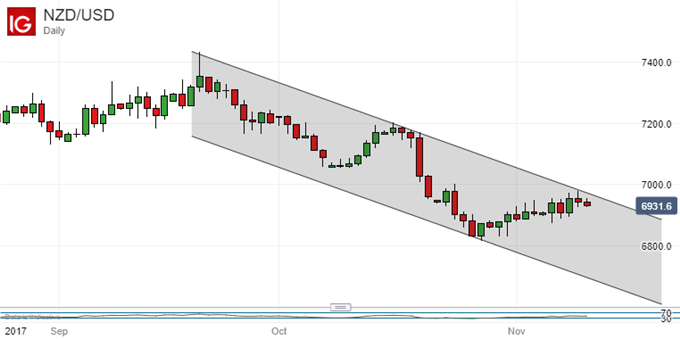Talking Points:
- The New Zealand Dollar fell after Finance Minister Grant Robertson spoke
- He said that an additional, employment mandate for the Reserve Bank could mean looser monetary policy
- However nothing has been decided yet
Trade the major economic data and join the discussion about what it means at the DailyFX Webinars. We would love to have you along.
The New Zealand Dollar fell Friday after the country’s new Finance Minister flagged up the possibility of some changes to the way monetary policy is conducted.
Speaking in Wellington Grant Robertson said that the Reserve Bank of New Zealand’s 2% inflation target could be up for discussion although the government remains committed to the current 1-3% inflation band.
At present the RBNZ sets policy targeting an annualized Consumer Price Index rise of 2% over time, with the leeway to keep inflation within that broader band. The central bank is something of a pioneer in the inflation-targeting monetary policy now in force across much of the world.
The new government has said it is open to including some form of additional employment target in the RBNZ’s monetary mandate, even if it is less specific than the government’s own, first-term 4% target. NZ joblessness is currently running at 4.6%. Robertson said that a dual mandate- targeting both inflation and employment- “may mean looser policy in some instances,” and it was probably those words which did the damage to NZD/USD.
Still, Robertson reminded listeners that the government was “committed” to keeping the policy band and that there was as yet no proposal to change the 2% midpoint either. However, he did say that when a new RBNZ governor was appointed- hopefully before this year ends- there could be discussions about the latter.

New Zealand’s Official Cash Rate stands at a record low of 1.75%, and was left on hold again this week, although the Kiwi rose following that decision as the RBNZ was viewed as having become slightly more hawkish on rate policy.
NZD/USD has been in broad retreat since it posted 2017’s peak back in July. October’s formation of a Labour-party-led coalition had not been what NZD bulls wanted, judging by the currency’s reaction to opinion polls before the vote. However, they do seem to be learning to live with it, and NZD/USD has now started to find its feet and is set to challenge the top of its uptrend channel.

It’s worth pointing out though that a very similar pattern can be seen in AUD/USD which may suggest that the “USD” side of both currency pairs is really the side to watch.
--- Written by David Cottle, DailyFX Research
Contact and follow David on Twitter: @DavidCottleFX






